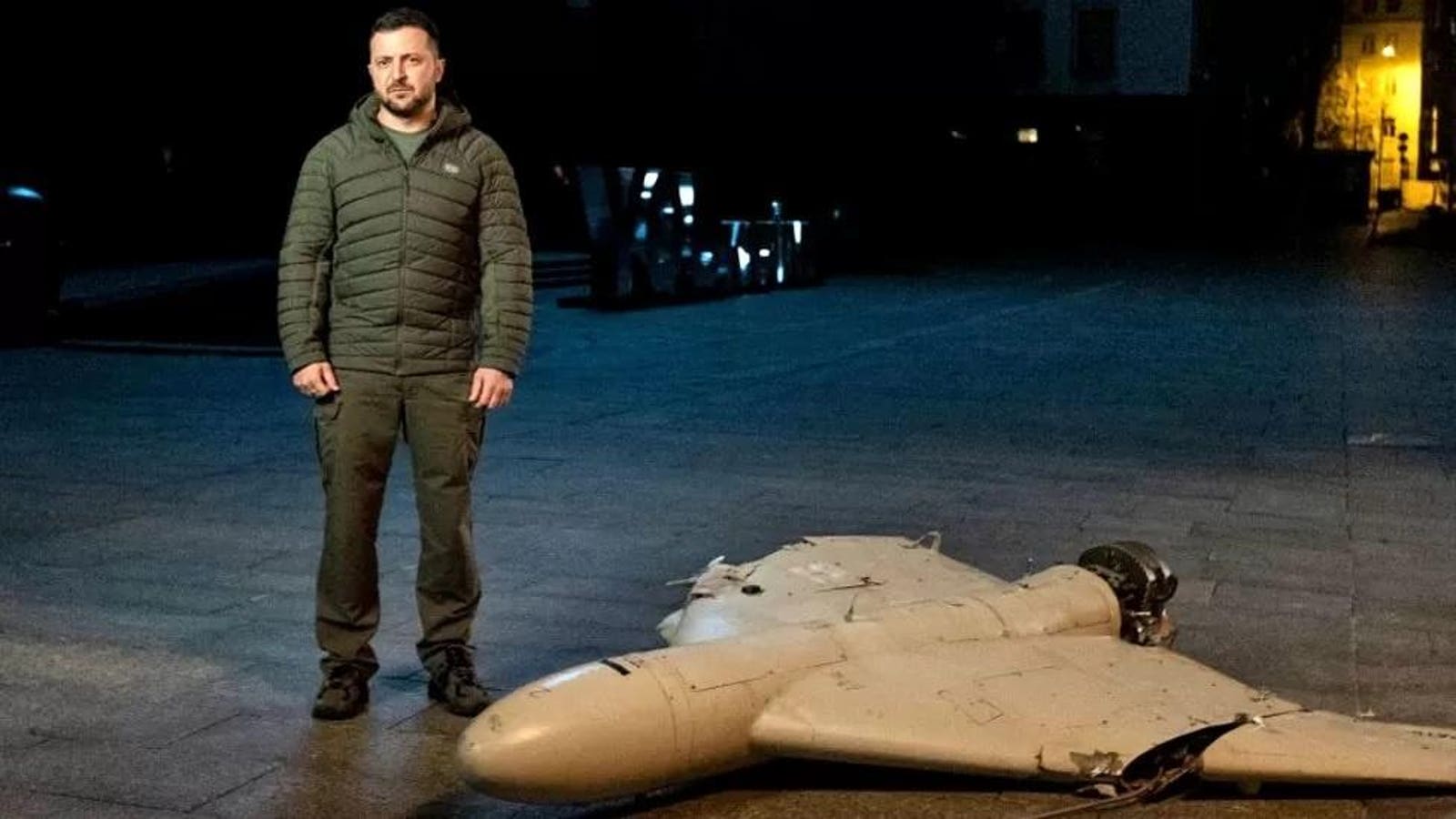Russia's Largest Drone Attack On Ukraine: Military Reports Surge In Unmanned Aerial Vehicles

Table of Contents
Scale and Scope of the Drone Attack
The scale of Russia's recent drone assault on Ukraine represents a significant escalation in the conflict. Reports from various credible sources, including the Ukrainian Ministry of Defense and NATO intelligence assessments, suggest a wave of attacks far exceeding previous incidents. While precise figures vary slightly depending on the source, the consensus points to hundreds of unmanned aerial vehicles being launched in a coordinated attack.
The drones used were primarily Shahed-136 loitering munitions, along with other Iranian-made drones, showcasing the increasing reliance on these relatively inexpensive yet effective weapons. These UAVs, known for their suicide capabilities, target critical infrastructure and military sites, maximizing their destructive potential.
The geographic targets of the attack spanned a wide area across Ukraine. Major cities like Kyiv were hit, along with vital energy infrastructure facilities in the south and east, and several military bases. The widespread nature of the attack demonstrates a concerted effort to cripple Ukraine's defenses and inflict maximum damage.
- Number of drones launched: Estimates range from several hundred to over 500.
- Types of drones used and their capabilities: Primarily Shahed-136, along with other Iranian-made UAVs; known for their low cost, long range, and suicide attack capabilities.
- Specific locations targeted within Ukraine: Kyiv, Odesa, Kharkiv, energy grids, military bases, and other critical infrastructure points.
- Sources of information: Ukrainian Ministry of Defense, NATO reports, independent military analysts.
Military Response and Defense Strategies
Ukraine's response to this massive drone attack highlighted the challenges of defending against such a large-scale assault. While Ukraine deployed a combination of air defense systems, including Patriot and NASAMS missile systems, along with other domestically produced and Western-supplied systems, the sheer number of incoming drones strained their defensive capabilities.
The effectiveness of Ukrainian air defenses varied. While many drones were intercepted, a significant number successfully reached their targets, causing damage to infrastructure and resulting in casualties. This underlines the ongoing need for advanced and robust air defense systems to counter this new threat. The increase in attacks is also pushing Ukraine to adapt its defensive strategies, including focusing on early warning systems, electronic warfare tactics, and potentially developing more counter-drone technologies.
- Specific air defense systems used: Patriot, NASAMS, and various other Ukrainian and Western-supplied systems.
- Success rate of interception efforts: Reports vary, but a substantial portion of drones were intercepted, though many still breached defenses.
- Damage inflicted despite defensive measures: Damage to energy infrastructure, civilian areas, and military assets occurred despite defensive efforts.
- Adaption of Ukrainian defense strategies: Increased reliance on early warning systems, improved coordination of air defenses, and development of counter-drone technologies are crucial responses.
Geopolitical Implications and International Response
Russia's largest drone attack on Ukraine has significant geopolitical implications. The reliance on Iranian-made drones deepens the entanglement between Russia and Iran, raising concerns about the regional balance of power and the potential for further escalation. The attack also demonstrates the changing dynamics of modern warfare, emphasizing the increasingly prominent role of UAVs in conflict.
The international community responded with widespread condemnation of the attacks. The UN and NATO issued strong statements expressing concern and calling for an end to the violence. Many Western nations announced further military aid to Ukraine, focusing on strengthening its air defense capabilities and countering the drone threat. The attack underscores the need for international cooperation in preventing the proliferation of lethal autonomous weapons systems (LAWS).
- Statements from international organizations (e.g., UN, NATO): Strong condemnation of the attacks and calls for an end to the conflict.
- Reactions from other countries involved: Increased military aid to Ukraine, sanctions against Russia and Iran, and diplomatic pressure.
- Potential escalation of the conflict: The attack has raised concerns about further escalation and the potential for wider regional conflict.
- Impact on global security and arms control: The incident highlights the urgent need for international cooperation on regulating the development and use of UAVs.
The Role of Iranian-Made Drones
The use of Iranian-made drones in this attack is a critical aspect to consider. Intelligence reports strongly indicate that Russia is receiving a substantial supply of Shahed-136 and other Iranian UAVs, enabling the scale of the recent assault. This collaboration poses a significant threat to regional stability and underscores Iran's growing involvement in the conflict. The implications extend beyond the immediate battlefield; the provision of these weapons to Russia by Iran has triggered renewed international sanctions and heightened tensions between Iran and the West.
- Evidence linking the drones to Iran: Physical examination of downed drones, intelligence reports, and satellite imagery.
- International sanctions concerning drone supply: International pressure is mounting on Iran to cease supplying drones to Russia.
- Impact on US-Iran relations: This support to Russia has further strained already tense US-Iran relations.
Conclusion
Russia's latest drone attack on Ukraine marks a significant escalation in the conflict, demonstrating an unprecedented scale of unmanned aerial vehicle deployment. The attack highlights the evolving nature of modern warfare, with drones playing an increasingly crucial role. Ukraine's response, though resilient, underscores the urgent need for enhanced air defense systems and counter-drone technologies. The geopolitical ramifications are substantial, affecting the relationship between Russia and Iran, and prompting a stronger international response. The proliferation of these weapons necessitates a global conversation about effective arms control and responsible use of UAVs. This escalation of Russia's drone attacks on Ukraine demands continued vigilance and analysis. Stay informed and follow the ongoing developments in this crucial aspect of the conflict. To further understand the technological advancements and strategic implications of this evolving conflict, explore reputable news sources and military analysis websites.

Featured Posts
-
 Fsu Shooting Victims Family History From Cuban Exile To Cia
May 19, 2025
Fsu Shooting Victims Family History From Cuban Exile To Cia
May 19, 2025 -
 Music Festivals And London Parks Mark Rylances Strong Criticism
May 19, 2025
Music Festivals And London Parks Mark Rylances Strong Criticism
May 19, 2025 -
 Indian You Tuber Jyoti Malhotra Pakistan Spy Allegations
May 19, 2025
Indian You Tuber Jyoti Malhotra Pakistan Spy Allegations
May 19, 2025 -
 Ierosolyma I Eorti Toy Eyaggelismoy Tis T Heotokoy Kai I Simasia Tis
May 19, 2025
Ierosolyma I Eorti Toy Eyaggelismoy Tis T Heotokoy Kai I Simasia Tis
May 19, 2025 -
 Restauration De Notre Dame De Poitiers Progres Et Appel Aux Dons
May 19, 2025
Restauration De Notre Dame De Poitiers Progres Et Appel Aux Dons
May 19, 2025
